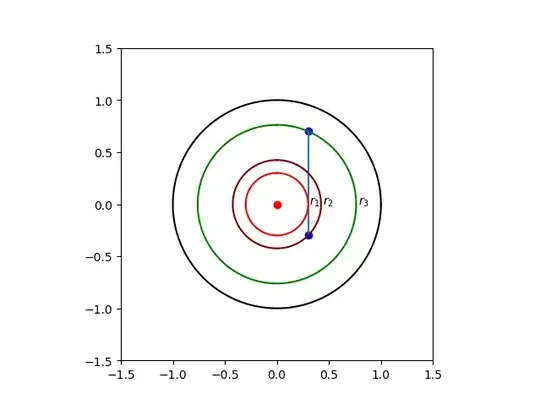In a circle, a chord will be drawn by connecting two uniformly random points on the circle. Where in the circle should you draw a line segment of fixed length, to maximize the probability that it will be intersected by the chord?
My attempts suggest (but do not prove), perhaps counter-intuitively, that the line segment should be drawn so that it is a chord of the circle.
ATTEMPT $1$
Let the radius of the circle be $1$, and let the length of the line segment be $2L$, where $L<1$.
In deciding where to draw the line segment, the variables are:
$p=$ distance between centre of circle and midpoint of line segment
$\theta=$ acute angle between line segment, and line through centre of circle and midpoint of line segment.
The diagram shows the line segment in red, and one of the randomly chosen points on the circle.
For each value of angle $x$, the probability that the line segment is intersected by the random chord, is $C/\pi$.
The overall probability is the average value of $C/\pi$, as angle $x$ goes from $0$ to $2\pi$.
It takes a bit of work to express $C$ in terms of $L, p, \theta, x$:
$a=\sqrt{p^2+L^2-2pL\cos{(\pi-\theta)}}$ (cosine rule)
$A=\arcsin{\left(\frac{L\sin{(\pi-\theta)}}{a}\right)}$ (sine rule)
$b=\sqrt{1^2+a^2-2a\cos{(A+x)}}$ (cosine rule)
$c=\sqrt{1^2+p^2-2p\cos{x}}$ (cosine rule)
$\cos{B}=\frac{b^2+L^2-c^2}{2bL}=\frac{b^2+(2L)^2-d^2}{4bL}$ (cosine rule) $\implies d=\sqrt{2L^2-b^2+2c^2}$
$C=\arccos{\left(\frac{b^2+d^2-(2L)^2}{2bd}\right)}$ (cosine rule)
$P=P(\text{line segment is intersected by chord})=\frac{1}{2\pi}\int_0^{2\pi}\frac{C}{\pi}dx$
Putting all of this into my computer, it seems that, for any value of $L<1$, $P$ is maximized when the line segment is drawn as a chord of the circle. But trying to prove this analytically seems daunting.
ATTEMPT $2$
Consider a disk of radius $r<1$ placed inside a unit circle. The distance between their centres is $t$, and $P(t)$ is the probability that a random chord (chosen by connecting two uniformly random points on the unit circle) will intersect the disk.
We will try to show that $P(t)$ is an increasing function in $t$. Then in the original question, regard the line segment as a rigid row of many small disks. When the line segment (i.e. row of disks) is a chord of the unit circle, the $t$-value of each small disk is maximized, so the probability that the line segment is intersected by a random chord is maximized.
The diagram shows a disk, and one of the randomly chosen points on the circle.
For each value of angle $x$, the probability that the disk is intersected by the random chord, is $\alpha/\pi$.
The overall probability is the average value of $\alpha/\pi$ as angle $x$ goes from $0$ to $2\pi$.
$\alpha=2\arcsin{\left(\dfrac{r}{\sqrt{1+t^2-2t\cos{x}}}\right)}$
$P(t)=\dfrac{1}{\pi^2}\int_0^{2\pi}\arcsin{\left(\dfrac{r}{\sqrt{1+t^2-2t\cos{x}}}\right)}dx=\dfrac{2}{\pi^2}\int_0^{\pi}\arcsin{\left(\dfrac{r}{\sqrt{1+t^2-2t\cos{x}}}\right)}dx$
We can express the integral as a riemann sum, then differentiate with respect to $t$, then express the new riemann sum as an integral. So we get:
$\dfrac{dP(t)}{dt}=\dfrac{2r}{\pi^2}\int_{0}^{\pi}\dfrac{\cos{x}-t}{(1+t^2-2t\cos{x})\sqrt{1+t^2-2t\cos{x}-r^2}}dx$
Since $r$ will approach $0$, I think we can ignore the $r^2$ in the denominator.
So we just have to show that $\int_{0}^{\pi}\dfrac{\cos{x}-t}{(1+t^2-2t\cos{x})^{1.5}}dx>0$ for $0<t<1$, but I do not know how to show this. I found a related question, but it has not helped me.
ATTEMPT $3$
I tried to use the method in the answer of @Gribouillis below to get an expression for the probability that the line segment will be intersected by a random chord, but it does not seem to make the maximization problem any easier than my "Attempt $1$".
EXTRA INFORMATION
$P$ seems to be minimized when the line segment's midpoint is at the centre of the circle. The ratio of the maximum to minimum probabilities seems to approach $\pi/2$ as $L\to0$.
Just for fun, I asked my high school students this question, and asked them to use their intuition, with the following choices:
24 students chose A.
18 students chose B.
10 students chose C.
6 students chose D.



